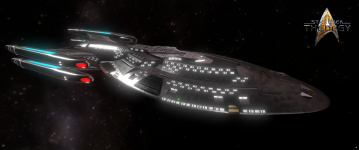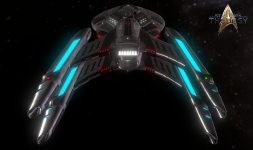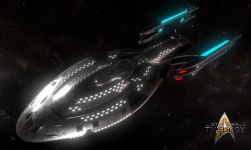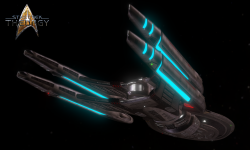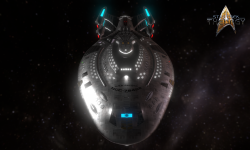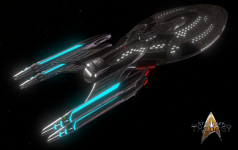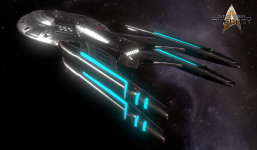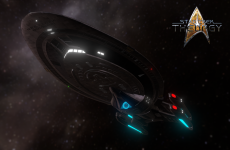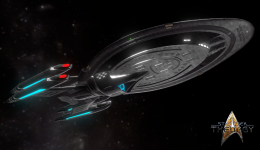USS Oneida
From Star Trek: Theurgy Wiki
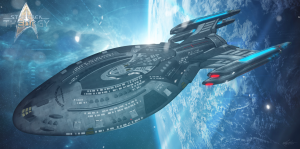
| |
| Vessel Name: | USS Oneida |
| Registry: | NCC-78497 |
| Starship Class: | Iroquois-class |
| Starship Type: | Long Range Explorer |
| Status: | Active |
| Purpose: | Exploration & Scientific Research |
| Constructed: | San Francisco Fleet Yards & Utopia Planitia Fleet Yards |
| Commissioned: | January 18th, 2376 (2 years after the prototype, the USS Iroquois) |
| Dedication: | “We shall not cease from exploration, and the end of all our exploring will be to arrive where we started and know the place for the first time.” - T.S. Eliot |
| Dimensions: |
|
| Mass: | 3,000,000 metric tons |
| Decks: | 17 |
| Standard Crew Complement | 250 |
| Maximum Cruising Speed |
Warp Factor 8.5 |
| Standard Cruising Speed | Warp Factor 7.5 |
| Armaments: |
|
| Defences: |
|
| Auxiliary Craft |
|
| Design: |
Auctor Lucan |
| 3D Model: |
Kalashnikov 3D |
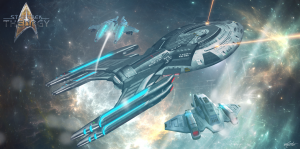 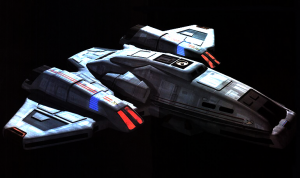 
| |
The USS Oneida (NCC-78497) was a late 24th century Federation Iroquois-class starship operated by Starfleet. Like other ships of its class, it was a joint construction project between the San Francisco Fleet Yards and Utopia Planitia Fleet Yards.
The USS Oneida, the fourth Iroquois class starship commissioned, was launched in 2375. It was assigned to the Beta Quadrant to replace starships that were called to the front of the Dominion War. At the time, Starfleet was hesitant to place a starship of such a new and untested design in harm’s way until evaluations could reveal how the Iroquois-class handled itself in the field.
It would encounter the SS Sabine in Episode 01: Advent of War, in Season 2 of Star Trek: Theurgy.
Starship Demonstration
History
By the mid-2370s, the success and failures of the Intrepid-class were clear to Starfleet. Her mechanically moving nacelles proved to be both a maintenance nightmare and unfitting for sustained speed at higher warp factors, so the development of an upgraded long-range exploratory craft began. Thus, the Advanced Starship Design Bureau designed the next great explorer; the Iroquois-class. The name was picked in tribute to the Native Americans of centuries past, and because the Iroquois-class' improved warp geometry was partially based on the quad-nacelle Cheyenne-class.
The USS Iroquois, the first of its class, was launched in 2374 to great fanfare and was quickly seen by the Federation Science Council as a valuable resource. It was still small compared to the Galaxy-class, yet larger than the Intrepid, containing the best technology available to the United Federation of Planets as of its commissioning date. It was contemporary with the Prometheus-class, and they both shared some design characteristics.
The sleek curves of the Iroquois-class weren’t just a stylistic choice, they assisted the quad-geometry warp nacelles in producing a tight warp field over the starship with a steep and stable field gradient in even turbulent space-time conditions, giving the ship both an impressive warp acceleration and stability. These features, along with the vessels primary Class-9 warp drive and its secondary warp assembly allowed the class an impressive top speed and unmatched durability of warp 9.99 for 2 weeks. This achievement was made possible by the symmetry of the compact warp nacelle assembly. Not only did it use tetryon warp plasma like the Prometheus-class, but it also enabled the use of a redundancy cycle, which allowed the warp coils to be taken offline for mid-warp maintenance.
With these speeds being standard, it was deemed necessary to develop a customized navigation system, the RAV/ISHAK Mod 3a warp celestial guidance system, specifically designed to handle the ship's high warp capability. They were also equipped with the best technology in the Federation as of 2374, including the newest generation of multi-spectral subspace sensors linked into the most powerful shipboard computer yet in service in Starfleet. It would only be surpassed by the Vesta and Theurgy-class ships later in the 2370s'. This computing power was possible through a breakthrough in the use of bio-neural circuitry on the Intrepid-class, only refined in this new explorer, allowing the vessels’ computer to form information connections in a faster and more natural way, giving the main computer the unique ability to adapt to new and confusing situations as well as improvise solutions. This increased computer power allowed the Iroquois-class more automation than many Starfleet vessels, keeping the typical crew rosters down to between 230-270 officers and crew, which was quite low for a ship of its size. This allowed for plenty of room for civilian scientists and researchers.
As it was a deep-space exploratory vessel, all Iroquois-class starships had an impressive amount of tactical systems as standard, the reasoning being that it would be operating far from any other allied starships and may need to defend itself against multiple attackers. The Iroquois-class had nine Type-XI phaser strips and four torpedo launchers (two forward, two aft). To further planetary exploration, all Iroquois-class vessels were assigned at least one Argo-shuttle, four Type-9 and Type-9A shuttlecraft in addition to the aeroshuttle that was located on the ventral side of the primary hull, being a refit of the model that Intrepid had been fitted with in 2370.
For crew recreation, new high resolution holo-emitters and integrated replicator systems made holodecks power efficient and able to create permanent matter in the simulation to prevent continual holo-emitter use and degradation. These same holo-emitters were also installed in a limited-purpose ship-wide hologrid, allowing the Mk II Emergency Medical Hologram system (EMH) to assist medical personnel when they required it anywhere aboard the ship.
Since its sustained warp speeds were so considerable, Starfleet lauded the design as its new deep-space explorer, and mass production began in 2375.
Commissioned Iroquois-class Starships as of March 2381
- USS Iroquois NX-78494, Prototype
- USS Mohawk NCC-78495
- USS Seneca NCC-78496
- USS Oneida NCC-78497
- USS Cayuga NCC-78498
- USS Onondaga NCC-78499
Deck Layout (Under Construction)
- Deck 1
- Main Bridge, Captain's Ready Room, Briefing Room
- Deck 2
- Stellar Cartography, Astronomy Labs, Communication Hardware
- Deck 3
- Senior Officers Quarter, Captain's Quarters, Operation Offices, Life Pods
- Deck 4
- Transporter Room I, Security/Armory/Brig, Conference Room, Holodeck 01
- Deck 5
- Junior Officer's Quarters, Gym, Multi-purpose room, Life Pods
- Deck 6
- Computer Core, Library, Sciences Labs, Cargo Holds A - G
- Deck 7
- Computer Core, Sickbay, Quarantine, Decontamination Chamber, Doctor Offices, Counseling Suite, Diagnostic Labs, Transporter Room II (6 person)
- Deck 8
- Computer Core, Warp-Trail Lounge, Life Science Labs, Life Pods
- Deck 9
- Family Deck, Crew Quarters, Café, Day Care/School, Life Pods
- Deck 10
- Shuttle Bay, Entertainment Deck, Ship Lounge, Holo Decks II-V, Game Room, Cargo Hold H
- Deck 11
- Diplomatic Deck, VIP Suites, Transporter Room II (6 person), Diplomatic Conference Rooms, Formal Dining Room.
- Deck 12
- Crew Quarters, Life Pods, common mess, Sensors, Navigational Deflector
- Deck 13
- Crew Quarters, Secondary purpose Evacuation and Marine Transport (A level), Navigational Deflector
- Deck 14
- Crew Quarters, Secondary purpose Evacuation and Marine Transport (B level), Navigational Deflector
- Deck15
- Phaser Arrays 1-12, Targeting and Firing Control, Deuterium Storage, Main Deflector
- Deck 16
- Engineering Deck, Warp Core, Secondary Bridge, Tractor Beam, Probe launcher, Sensors
- Deck 17
- Main Engineering Deck, Warp Core, Transporter Room III (4 person), Cargo Holds I-O, Life Pods
Aerowing Shuttle
Mounted on the underside of the saucer section, the Aerowing rested in a recessed hatchway just aft of the ventral sensor array. The craft served in the capacity of a runabout aboard larger ships. In fact the Aerowing’s technology and design was based, in large part, on the Danube class runabout. The Aerowing provided a large secondary craft, long-range travel, and the protection, armament, and sensor capabilities beyond that of a standard auxiliary shuttle.
Facilities included two sleeping bunks and a standard runabout passenger cabin. A replicator and flight couches provided for the needs of the passengers and a two-person transporter allows for beaming of personnel or cargo when needed. Atmospheric flight capabilities allowed this shuttle type to land on planetary surfaces.
Warp-Trail Lounge
The Warp-Trail Lounge was located in the aft section of the Oneida`s observation deck, nestled between the ship's two upper warp nacelles. The proprietor, a Human man named Remy Lafayette, was a smooth talking Dominion War veteran who was missing his left forearm just past the elbow. The Cajun was famous for telling people that he lost it after making a stupid remark to a Gorn about eating gators, and that they tasted like chicken.
As you walked into the Warp-Trail Lounge, you would find yourself in a dimly lit, "L" shaped room. The tail of the L ran off to the right, the far wall of which was taken up by the bar: A long counter of dark polished wood with 10 stools positioned along it. Running down the opposite wall, along the long wall of the "L", were 10 booths. The booths were semi-circular tables, the flat edge of which faced out away from the wall. The benches wrapped around the inside of the table, giving enough room to seat up to 4 people in each booth. The booths were divided by wooden panels that rose 2 feet higher than the back of the curved bench seats, and provided each booth a certain amount of privacy from the adjacent booths. The wall behind each booth was dominated by a large square viewport which looked out from the ship's stern. Through these viewports one could watch as the stars faded off into the distance as the ship moved through space, and the warp nacelles could be seen extending out form the rear of the ship on either side.
There was also a smattering of tables scattered throughout the floor of lounge. At the top of the "L" was the stage, a raised platform upon which sat a glossy black grand piano. Mounted in the ceiling above the stage were several holo-emitters, which allowed for a variety of entertainment to be provided for the patrons of the lounge, be it a pianist, singer, or comedian. Immediately in front of the stage was a clear area that could be used as a dance floor should the urge strike.
Iroquois-class Gallery
Known Crew
These were the known crew of the USS Oneida at the point of its encounter with the SS Sabine in Episode 01: Advent of War, in Season 2 of our story. More detail about these officers can be found here, on the Story NPCs page.
Commanding Officers
- Captain Jesse 'JJ' Jackson, Human.
Command Crew
- Executive Officer
- Commander Mag'Lev, Tellarite.
- Second Officer
- Lt. Commander Wogak Ikthan, Rigelian Jelna
- Chief Tactical Officer
- Lt. Commander Wogak Ikthan, Rigelian Jelna
- Chief Engineering Officer
- Lt. Lozrah "Loz" Grian, Trill
- Chief Medical Officer
- Lt. Kaneko Aio
- Chief Counselor
- Lt. Cmdr. Murphy Caldera, Human
- Chief of Operations
- Lt. Bob, Delphine, Chief of Operations
- Chief Security Officer
- Lt. Rodrigo Rivera
